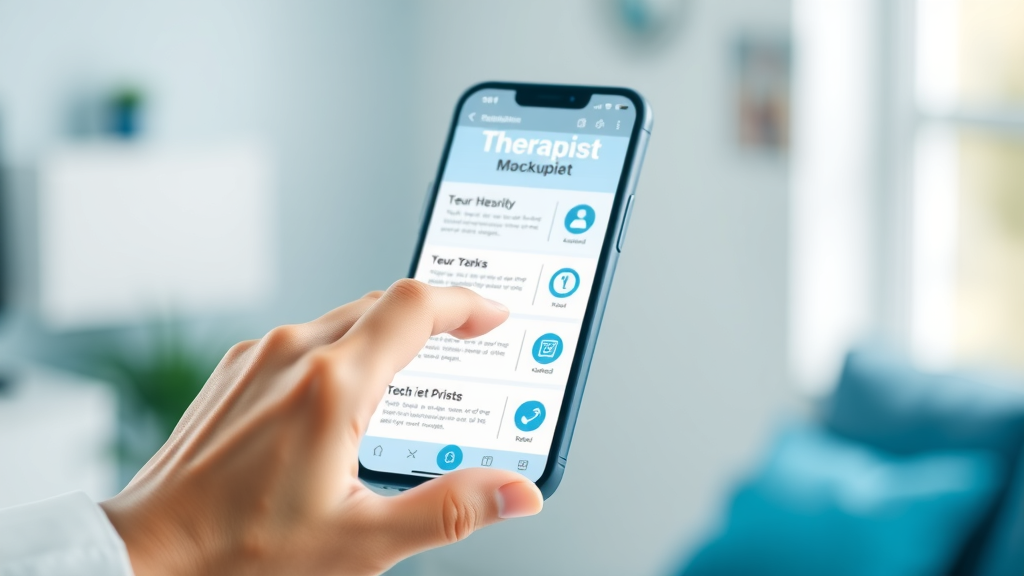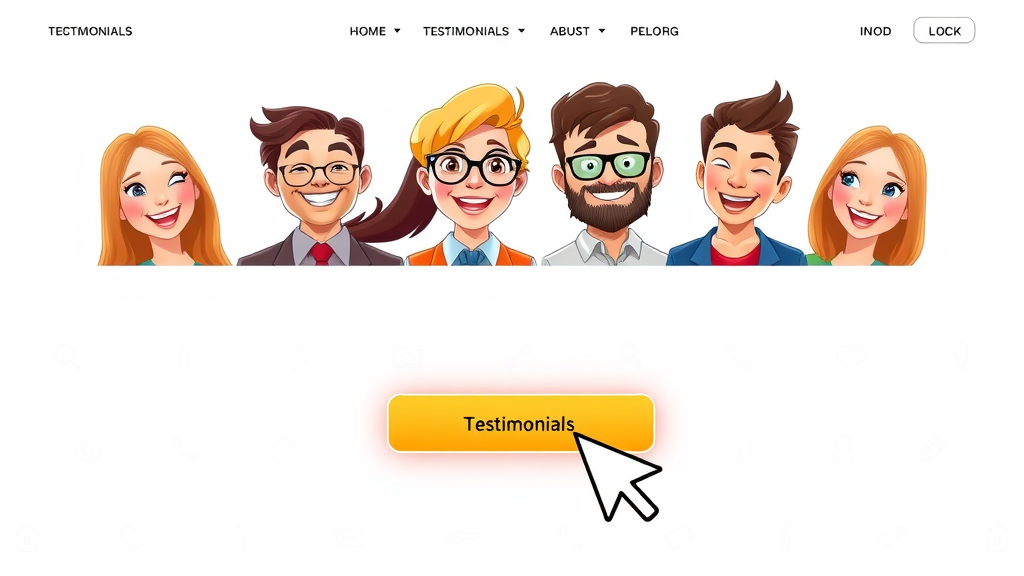
Did you know that over 80% of people in need of mental health services begin their search for a therapist on search engines? Elevating your therapy practice’s SEO is no longer an option—it’s a necessity.
- Understand what SEO for therapy practices involves
- Learn proven strategies to optimize your website
- Gain actionable insights on reaching potential clients online
- See how SEO for therapists can drive your private practice’s success
- Learn how to utilize social media, keyword research, and link building for lead generation
Unlocking the Power of SEO for Therapy Practices in a Digital World
Why Search Engine Rankings Matter for Therapy Practices
SEO for therapy practices isn't just a marketing trend—it's the backbone of reaching and supporting those seeking mental health services. Today, a therapy practice's visibility in search engine rankings can be the difference between a thriving private practice and an unheard presence. High placements on search engine results pages (SERPs) let your services become discoverable for people often deciding on their next steps in moments of vulnerability and need.
When your site appears atop search results for mental health keywords, trust is established even before the first click. Studies show users are far more likely to contact a private practice that ranks highly, viewing it as credible and authoritative. In this increasingly digital landscape, not investing in a tailored SEO strategy means certain clients may not find your specialized care—even if you’re the best option in their area.
By mastering SEO, therapy practices can cut through online noise, ensure they show up for searches like “anxiety therapist near me,” and turn a passive website into a key driver for client growth. Let’s examine the proven steps to rise above competing therapy practices and meet clients where their healing journey begins: the search bar.
How Effective SEO for Therapy Practices Attracts Potential Clients
The art of SEO for therapists is about more than ticking boxes for search engine optimization ; it requires a targeted focus on the needs and behaviors of potential clients . Effective SEO connects your specialty—whether it’s trauma, couples counseling, or adolescent therapy—with real people searching for those services. By refining your site’s content and architecture, you’ll not only reach more users but also engage those most likely to become long-term clients.
A well-optimized therapy practice website speaks to intent. Instead of vague keywords, it targets phrases and questions clients actually use (“How do I find a therapist for anxiety?”), as well as local keywords that signal readiness to book (“best therapist in [Your City]”). Ranking for these searches positions your website as the most relevant and reputable choice. As users find personalized solutions and resources, the path from website visitor to booked appointment becomes seamless, fostering both trust and connection.
More importantly, targeted SEO increases your authority with search engines, helping your practice stand out from general directories or larger mental health portals. In a competitive landscape, even modest improvements in ranking can lead to huge gains in client contacts and clinical impact.

SEO for Therapy Practices: Core Concepts and the Search Engine Landscape
Understanding SEO for Therapists and Mental Health Professionals
At its heart, SEO for therapy practices means enhancing every element of your digital presence to increase your practice’s findability on platforms like Google or Bing. This process begins with understanding how your private practice shows up on search engines when clients search for relevant mental health topics, conditions, or treatment modalities. SEO isn’t a single tactic, but a suite of interconnected strategies—ranging from technical tweaks to content production—that all work together to deliver results.
Mental health professionals benefit from SEO that elevates their specific areas of expertise—be it depression, trauma therapy, or mindfulness counseling. When optimized thoroughly, your website, Google Business Profile, and online directories align to provide a cohesive digital identity. For every potential client conducting a search, your therapy practice appears relevant, trustworthy, and accessible in their time of need.
For therapists new to SEO, focusing on the essentials—like properly formatted pages, keyword-rich titles, and compelling content—ensures that both search engines and prospective clients see you as a leader in mental health care.
A Closer Look at Search Engines and How They Impact Private Practice
Search engines like Google use complex algorithms to rank websites for billions of daily inquiries—including those for counseling or therapy. The goal is always the same: provide users with the most helpful information tailored to their exact question or need. For a private practice , appearing at the top of these rankings is critical for gaining attention and earning more bookings.
Factors such as the quality of your content, user friendliness of your site, and technical SEO (e.g., fast loading speeds, mobile readiness) all influence how your therapy practice appears on a search engine results page . By implementing SEO best practices, therapists can actively shape how often and how highly their website is ranked—making it simpler for those seeking help to find the right support.
Ultimately, dominating local and niche-specific search results turns your online presence into a reliable source of new clients. As more people start their therapy journey online, the gap between “just being listed” and “being chosen” only widens.
Common SEO Terms: Keywords, Title Tags, Meta Descriptions, and Ranking Factors
To succeed with SEO for therapy practices , it’s vital to understand fundamental terms:
- Keywords : Words and phrases that potential clients type into search engines related to mental health services, conditions, or locations.
- Title Tags : The clickable headline displayed in search results, which should succinctly describe each page’s main topic.
- Meta Descriptions : Short summaries that appear under title tags in search engine results, enticing users to click with clear value propositions.
- Ranking Factors : A diverse set of elements—content quality, backlinks, technical performance, user experience—that determine where your website is displayed on results pages.
By strategically using keywords in your title tags and meta descriptions, and understanding what ranking factors matter most, you set the stage for higher engine rankings and more meaningful connections with those seeking help.
SEO may sound technical, but for therapy professionals, it’s grounded in the same principles as counseling: clarity, authority, and trust.
Strategic Keyword Research for SEO for Therapy Practices
Identifying Therapy Practice and Mental Health Keywords
Effective SEO for therapy practices begins with finding the keywords that resonate with your target audience. Start by brainstorming the services your private practice offers and common issues clients search for, such as “anxiety counseling,” “family therapy near me,” or “EMDR therapist.” Using keyword research tools like SEMrush or Ahrefs reveals which terms have the highest volume and lowest competition, ensuring your website targets phrases that bring results.
Extensive research helps you uncover both broad and niche-specific keywords. If you’re a trauma specialist, incorporate terms like “PTSD therapy in [City],” while general practices should not overlook local phrases like “mental health therapist near [Neighborhood].” This targeted strategy means more potential clients find precisely what they’re looking for—your expertise.
Investing time in keyword research sharpens your competitive edge, aligns your content with what people actually search for, and increases your practice’s likelihood of topping the search engine results page .
Long-Tail Keywords and Search Intent for Therapists
Long-tail keywords are extended search phrases that reflect highly specific needs and intentions—“best child anxiety therapist in Brooklyn” or “mindfulness-based stress reduction for adults.” These terms often carry less competition and showcase your exact specialty. They also connect you with clients further down the decision-making path, making them more likely to book your services.
By aligning your website content around long-tail keywords, you improve your site’s relevancy for those who know what they’re seeking. Their search intent is clear, and your ability to address their concern—right on your homepage or blog—builds instant credibility. Adding FAQs and service pages around these phrases also helps your SEO strategy cover the full spectrum of client needs.
To maximize visibility, use long-tail keywords in combination with primary target terms, weaving them naturally into your site’s copy, titles, headings, and internal links. The result? Higher conversion rates and a steady stream of motivated new clients.
Analyzing Competitors: SEO for Therapists and Private Practice Keywords
Understanding which keywords your competitors rank for helps you identify gaps and capitalize on untapped search queries. Use tools like Google Search, SEMrush, or Ahrefs to review the title tag , meta description , and high-ranking pages of nearby therapy practices. Are they focusing on “telehealth therapy,” “depression counseling,” or “couples therapy in [Your City]”?
Competitor analysis also reveals content ideas, backlink opportunities, and local SEO strategies worth adopting or improving upon. By observing their on-page and off-page tactics, you can refine your own approach—focusing on under-served topics and frequently searched phrases in your area of expertise.
Ultimately, learning from the SEO efforts of other therapists gives your private practice an edge, allowing you to leapfrog to the top of the engine results page and capture clients your competition may overlook.
| Keyword | Monthly Searches | Competition | Search Intent |
|---|---|---|---|
| anxiety therapist near me | 1,300 | High | Transactional |
| online couples counseling | 720 | Medium | Transactional |
| child psychologist in [City] | 590 | Low | Commercial |
| depression therapy private practice | 320 | Medium | Transactional |

Optimize Your Website: SEO for Therapy Practices Starts Here
Best Practices for On-Page SEO for Therapy Practices
On-page SEO is the art of optimizing each page of your website to target both search engines and human readers. Effective SEO for therapy practices starts with:
- Using Primary & Secondary Keywords: Naturally weave top keywords (e.g., “anxiety therapy near me,” “child psychologist [City]”) into page titles, headers, and body content.
- Optimizing Title Tags and Meta Descriptions: Craft concise, descriptive titles and meta descriptions for each page—ensuring clarity for both Google and your potential clients .
- Structuring Content for Mental Health Topics: Break up your content with relevant headings (H1, H2, H3), bullet points, and digestible paragraphs. Create unique service pages for each specialty to improve your relevance for specific search terms.
Additionally, pay close attention to internal linking, mobile responsiveness, and accessibility features. These tactics make your site not just SEO-friendly, but welcoming and useful to new visitors as well.
On-page improvements produce immediate results—boosting time on site, lowering bounce rates, and sending strong positive signals to search engines. These technical and content tweaks lay the foundation for your entire SEO journey.
Private Practice Website Structure: Navigation and User Experience
User experience (UX) is a critical ranking factor in SEO for therapy practices . Simple, logical navigation ensures that clients can easily find your counseling services, resource guides, about pages, and contact information. Navigation menus should be uncluttered, using clear language (“About,” “Services,” “Book Now”) so patients can access help without confusion.
Organize your website into intuitive sections for each therapy service, condition treated, and information about your credentials. Add footers for privacy policies and links to vital practice information. Incorporating testimonials and FAQ sections also bolsters trust, helping potential clients make informed decisions right away.
Remember, the more effortlessly users can access your resources, the more search engines will reward your site in rankings. A streamlined, mobile-optimized structure enhances both online presence and real-world impact.
Technical SEO: Site Speed, Mobile Optimization, and Security
Behind the scenes, technical SEO is what enables your therapy practice website to load quickly, display seamlessly on all devices, and meet privacy and safety standards. Optimize images for fast loading, implement SSL certificates for site security (HTTPS), and use a mobile-responsive design to cater to users on smartphones and tablets.
The quicker and smoother your site, the longer people stay and the more likely they are to engage with your content. Google’s algorithms prioritize technically sound websites, rewarding them with higher search engine rankings. Routinely check your site’s health with tools like Google Search Console to catch broken links, slow pages, or crawl errors.
A strong technical foundation minimizes bounce rates and increases your chances of ranking well for competitive mental health keywords. In a digital era, technical SEO isn’t optional—it’s a non-negotiable investment for private practice websites.
| SEO Element | Best Practice | Status |
|---|---|---|
| Title Tag | Include primary keyword, under 60 characters | ✔️ |
| Meta Description | Summarize page content, under 160 characters | ✔️ |
| Header Structure | Organize sections with H1, H2, H3 tags | ✔️ |
| Mobile Optimization | Responsive design for all devices | ✔️ |

Content Strategy: Building Authority in Mental Health with SEO for Therapy Practices
Writing High-Quality, Optimized Content for Potential Clients
High-quality content demonstrates your expertise and helps you connect with potential clients at every step of their journey. Go beyond basic descriptions by providing in-depth but approachable articles, FAQs, and resource pages addressing key mental health conditions and therapy approaches. This positions you as a thought leader and trusted advisor within your field.
Include actionable tips, compassionate advice, and evidence-based strategies that empower users to take action or seek help. The more value you deliver, the more time users spend on site, the greater the likelihood they will reach out for a consultation—with direct benefits for your search engine ranking and credibility as a therapy practice.
Always write for both readers and search engines . Integrate keywords naturally, present information clearly, and ensure every piece of content is accurate and up to date. This builds a legacy of trust for both new visitors and returning clients.
Blogging for Search Engines: SEO for Therapists in Action
A blog is one of the most powerful tools for SEO for therapists . Consistently publishing informative, well-optimized articles demonstrates your clinic’s breadth of knowledge and increases your keyword coverage for search engine results . Blog topics should include:
- Mental Health Conditions and Treatments: Explore anxiety, depression, trauma, or ADHD in an approachable way.
- Therapy Approaches: Explain CBT, DBT, EMDR, art therapy, and other modalities.
- Success Stories (Case Studies): Share anonymized tales of client transformations to illustrate your impact.
With each new post, you increase your chances of ranking for relevant searches, drive new organic traffic, and create resources that can be shared on social media or local community groups.
Regular blogging builds long-term authority, keeps your website fresh, and helps answer the specific questions your audience is asking, resulting in more client bookings over time.
Optimizing Images and Media: Alt Tags, Captions, and Accessibility
Images play a key role in engaging visitors and improving SEO for therapy practices . For every photo, graphic, or logo, add descriptive alt text that uses relevant keywords (“mental health private practice office,” “therapist giving counseling session”). Alt tags aid in both SEO and accessibility, ensuring your site is inclusive for all users, including those using screen readers.
Captions and detailed file names further reinforce your topic authority—making your practice known for professionalism and trust. Compress images for faster loading, include schema markup on photos where possible, and always consider accessibility in your site’s design. Such best practices are applauded by both visitors and search engines alike, positively influencing your engine rankings .
Properly optimized media also provides fresh ways to appear in image results, local listings, and featured snippets, multiplying your digital visibility.
Leveraging Social Media to Amplify Your SEO Strategy
Social media is a powerful amplifier for your therapy practice’s SEO results. Sharing blog posts, resources, and success stories via platforms like Facebook, Instagram, or LinkedIn broadens your reach beyond traditional search traffic. Engaged audiences are more likely to click through to your site, share your content, and leave reviews—resulting in valuable backlinks and social signals that search engines consider when ranking sites.
Building a community on social media makes your private practice more approachable, encourages direct conversation with potential clients, and supports your overall SEO strategy . Cross-promote your website and social channels, use branded hashtags, and engage with other mental health organizations for maximum authority and exposure.
The result is a robust online presence that not only grows your site’s traffic but also fosters genuine relationships and increases booking rates.

Building Trust Online: Backlinks and Local SEO for Therapy Practices
Link Building Strategies for Mental Health Professionals
Backlinks—from other reputable sites to your own—are a gold standard indicator of trust for search engines. For therapy practices , link building might involve guest posting for mental health blogs, gaining citations in local news stories, or being featured on lists of recommended professionals.
Prioritize links from other therapists, professional organizations (like the APA or state psychological associations), and respected directories. Sponsor community events or offer expert commentary to be cited online. Each high-quality link signals to Google that your private practice is trusted, increasing your chances of higher search engine results placement.
Consistent link building creates a strong web of credibility that competitors will struggle to replicate—driving ongoing traffic to your practice for years to come.
Local SEO: Getting Found by Nearby Potential Clients
Local SEO is the key to attracting clients from your immediate area. Optimize your Google Business Profile with the correct NAP (name, address, phone number), upload professional photos, collect reviews, and ensure information is consistent across directories and listings. Local keywords—“counseling in [Your City],” “therapy office near me”—should feature throughout your site’s content.
Map listings, local citations, and posting updates about events or community involvement boost your chances of appearing in Google Maps and local packs—a critical page position for urgent, mobile-based searches. For therapy practices, mastering local SEO means clients can find help precisely when and where they need it.
As you build local authority, your practice stands out from digital directories, insurance networks, or nationwide portals, driving more direct appointments and turning search engine ranking into real-world results.
Online Directories and Reviews: Boosting Private Practice Authority
List your practice on prominent mental health and community directories—such as Psychology Today, TherapyDen, or GoodTherapy—and maintain up-to-date profiles. Solicit and respond to reviews from satisfied clients: positive feedback reassures searchers and enhances your credibility in both Google’s and users’ eyes.
Directory listings and reviews provide citation “backlinks” and act as trust signals for users ready to choose a therapist. Always monitor your online reputation, addressing negative feedback with professionalism and gratitude. Over time, an active presence on these sites will reinforce your private practice as an authority in the local mental health space.
Together, local SEO, online reviews, and strategic directory placements significantly elevate your practice’s online presence, making you the first call for those searching for mental health support.
| Source | Type | SEO Value |
|---|---|---|
| Psychology Today | Directory Listing | ⭐⭐⭐⭐ |
| Local Chamber of Commerce | Citation/Directory | ⭐⭐⭐ |
| Mental Health Blogs | Guest Posting | ⭐⭐⭐⭐ |
| Google Business Profile | Local Listing | ⭐⭐⭐⭐⭐ |

"A visible therapy practice is an accessible practice. SEO bridges the gap between you and those seeking help." – Leading SEO Strategist
Technical SEO for Therapy Practice Websites: Foundation for Search Engine Success
Ensuring Your Site Is Crawlable and Indexed by Search Engines
Search engines must be able to easily access and index your website content to consider it for rankings. Use clean URLs, proper header hierarchy, and XML sitemaps to guide bots through your entire site. Test your indexing status with Google Search Console—if key pages aren’t indexed, potential clients may never find them.
Avoid “orphan” pages (those with no internal links pointing to them), and update your robots.txt to ensure important content isn’t accidentally blocked. These technical steps make certain your therapy site is discoverable in search engine results, paving the way for future SEO wins.
Regular checks using tools like Screaming Frog or SEMrush catch indexing or crawl issues early, helping you stay a step ahead of competitors for top engine ranking .
Fixing Technical Issues: HTTPS, XML Sitemaps, and Robots.txt
Every therapy practice website should use HTTPS to secure visitor data, a must for modern search engine optimization . XML sitemaps provide search engines with a direct map to your site’s pages, speeding up indexing and visibility. Ensure your robots.txt file is configured to allow all necessary resources (JavaScript, CSS) to be crawled.
Minor technical setbacks—like slow loading times or duplicate content—can sabotage your search engine rankings. Schedule regular audits using Google Search Console or SEO audit tools, addressing issues as they arise and maintaining your domain’s health.
By proactively managing technical SEO, you lay the groundwork for sustainable growth, making sure every page is eligible for the search results your practice relies on.
Monitoring Site Performance and Addressing Errors
Site speed, mobile usability, and error-free experiences are non-negotiable for private practice SEO. Regularly track performance metrics in Google Analytics and Search Console. Address 404 errors, broken links, or mobile rendering problems as soon as they appear—these can all drop your pages out of top rankings.
Performance monitoring also means keeping plugins and scripts updated. If you run a WordPress site, limit bloat and unnecessary add-ons that slow things down. Prioritize user experience to increase engagement, lower bounce rates, and keep both users and search engines happy.
Stay vigilant with ongoing maintenance—a healthy website isn’t just a one-time achievement, but a continuous journey towards higher search engine rankings and better client outcomes.

Conversion Optimization: Turning Website Visitors into Potential Clients
Optimizing Calls to Action for Therapy Practices
A well-placed, clearly worded call to action (CTA) can make the difference between a casual visitor and a scheduled client. Include CTAs such as “Book a Free Consultation,” “Contact Us,” or “Find a Therapist Today” throughout your site, particularly atop pages, alongside services, and after blog posts. These prompts encourage users to reach out at critical decision moments.
CTAs should contrast visually with the rest of the site for maximum visibility and be linked directly to simple booking or inquiry forms. Experiment with different CTA texts and positions using A/B testing to discover what resonates most with your audience.
The easier you make it for website visitors to take the next step, the higher your conversion rates—and the faster your therapy practice grows.
User Experience & Trust Signals That Attract Prospective Clients
Trust is vital in mental health, and your website design should reflect care, competence, and confidentiality. Use professional photos, clearly displayed credentials, and real testimonials to assure visitors they are in good hands. Trust badges (“HIPAA Compliant,” “Licensed Therapist”) and security seals reassure clients of privacy.
Incorporate a visible About section detailing your philosophy, experience, and approach. An FAQ addressing privacy, payment, and insurance policies tackles client concerns up front. Streamlined design with soft colors, calming imagery, and easy-to-read fonts fosters a welcoming, non-intimidating environment—crucial for those seeking help.
Remember, every detail contributes to your overall online presence and helps turn first impressions into lasting therapeutic relationships.
Contact Forms, Booking Widgets, and Lead Capture for Mental Health Professionals
Simplicity and security matter most when capturing leads from therapy websites. Streamlined contact and booking forms (ideally requiring just a few fields) make it easy for anxious or busy potential clients to take action. Embed calendar widgets for real-time scheduling or live chat for immediate answers.
Ensure all forms are encrypted, mobile-friendly, and accessible, and send automated confirmation emails or reminders to nurture client relationships from the start. Add progress bars or multi-step forms only when necessary to reduce drop-off.
Consistent lead capture systems ensure no opportunity is lost—building your client base and growing your therapy practice with every site visit.

Tracking Progress: Analytics and SEO Metrics for Therapy Practices
Key Performance Indicators for SEO for Therapy Practices
Tracking the effectiveness of your SEO for therapy practices efforts is essential for ongoing success. Critical metrics include:
- Organic traffic growth (how many users are finding you from search engines)
- Search rankings for target keywords
- Bounce and engagement rates
- Contact or booking form submissions
- Backlink profile development
Analyze which blog posts, service pages, or local directory listings drive the most inquiries. Use this insight to guide future content and SEO strategy decisions—focusing on what brings the greatest client value.
Continuous monitoring and improvement ensure your investment in SEO translates directly into practice growth and clinical impact.
Using Google Analytics & Search Console to Measure Success
Google Analytics provides a comprehensive view of how users interact with your therapy website—tracking pageviews, session durations, and conversions. Search Console, meanwhile, reveals which queries bring your site traffic and highlights any technical or security issues.
Review keyword rankings, click-through rates from search engine results pages , and top-performing landing pages each month. Flag underperforming content for refreshes or additional optimization, and monitor the success of new tactics such as featured snippets or schema markup.
Together, these analytics platforms provide the actionable insights needed to adjust your SEO strategy and accelerate your private practice’s growth.
| Metric | Description | Target Value |
|---|---|---|
| Organic Traffic | Monthly visitors from search engines | +20% yearly |
| Keyword Rankings | Number of target keywords in top 10 | Top 3 for services |
| Lead Conversion | Contact/booking form submissions | 10+ per month |
| Backlinks | Domain authority from quality links | DA 30+ |

Advanced Strategies in SEO for Therapy Practices
Schema Markup and Structured Data for Search Engines
Schema markup adds a layer of structured data to your website’s code, making it easier for search engines to understand your services, locations, reviews, and practitioner profiles. This increases your chances of earning rich snippets, FAQ boxes, and star ratings in search results, which boost credibility and attract more clicks.
Implement schema for “local business,” “person,” “FAQ,” and “review” on key pages. Test your markup with Google’s Rich Results tool to ensure correct indexing and display. For therapy practices looking to stand out in crowded local listings, schema can be the difference-maker.
Proactive use of structured data signals expertise and authority—making your private practice more appealing to both Google and future clients.
Voice Search and Mobile-First SEO for Therapists
With more users relying on smartphones and smart speakers, optimizing for voice search is increasingly important. Focus on conversational, question-based keywords (“How do I choose a therapist?”) and short, clear answers that voice assistants can easily read.
Ensure your design is truly mobile-first: fast loads, touch-friendly menus, and content sized for any device. Mobile usability is heavily weighted in Google’s rankings, especially for local and urgent searches (“Find therapy near me now”).
By embracing emerging search habits, therapy practices can future-proof their SEO strategy and capture more leads from on-the-go searchers.
Staying Updated: SEO Trends in Mental Health and Private Practice
The world of SEO is fast-evolving. For consistent growth, monitor updates to Google’s search algorithms (such as core updates and local ranking changes), follow mental health SEO forums, and regularly audit your competitors’ rankings and tactics.
Stay abreast of trends like AI-generated content, video SEO for therapy explainer reels, and secure messaging for online booking. Proactive adaptation ensures your private practice remains at the cutting edge—turning changes into ongoing competitive advantages.
Connect with digital agencies specializing in SEO for therapists for tailored advice that reflects the ever-changing landscape of online marketing.
Case Studies: Real Results from SEO for Therapy Practices
Private Practice SEO Success Stories
Many therapy practices see exponential growth after implementing focused SEO strategies. For example, a mid-sized clinic in Austin, Texas, increased client bookings by 60% in six months by targeting long-tail keywords like “PTSD treatment Austin TX” and revamping their meta description for local searches. Another solo practitioner saw a surge of new inquiries after blogging about “adolescent depression” and optimizing directory profiles.
These real-world examples demonstrate the power and possibility that comes with dedicated, data-driven SEO efforts for therapists and mental health professionals.
Regardless of your practice’s size or specialty, the right approach can turn your website into your most consistent source of new client leads. The earlier you begin, the more ground you can gain in your local mental health landscape.
Common Pitfalls and How to Overcome Them
Therapists often struggle with SEO by using generic, duplicate content or neglecting Google Business Profile optimization. Others forget to update their websites regularly—leading to lower rankings as algorithms favor freshness and authority. Common technical errors (broken links, slow load speeds, lack of mobile optimization) can quietly erode your site’s visibility over time.
Combat these pitfalls by:
- Publishing original, well-researched posts and pages regularly.
- Performing quarterly site audits for technical issues.
- Staying consistent with content updating and local listing management.
Relentless focus on quality and usability keeps your site resilient in the face of shifting SEO trends.
Expert Tips from Leading SEO Agencies for Mental Health Professionals
Leading SEO for therapists consultants recommend:
- Claiming all major directory listings and uploading regular, SEO-optimized photos.
- Building networks with local healthcare professionals for natural backlink opportunities.
- Prioritizing search intent in every piece of content—always answer the “why” and “how” for potential clients.
- Using schema markup and detailed service descriptions for better rankings and rich snippets.
By acting on these expert recommendations, your private practice can harness the full power of modern SEO and establish an unshakeable lead in your market.
"Implementing the right SEO strategy can make the difference between an empty waiting room and a thriving therapy practice." – Mental Health SEO Expert
Common SEO Challenges for Therapy Practices and How to Solve Them
Overcoming Low Search Engine Visibility in the Mental Health Space
Many therapy practices face steep competition in crowded digital markets—making it tough to appear on the first page of search engine results . The solution: focus relentlessly on long-tail and local keywords, build high-authority backlinks, and create hyper-relevant content unique to your specialty and geography.
Review and optimize your site’s user experience and navigate technical SEO issues that might hold back your visibility. Even modest improvements in speed, mobile responsiveness, or internal linking can catapult you past slow-moving, generic competitors.
Local community outreach and active engagement on social media amplify your practice’s reputation—boosting both search and referral traffic.
Managing Time for Consistent SEO for Therapists
Therapists are busy, and building a robust online presence can easily slip down the priority list. Streamline your SEO workflow with monthly content calendars, automated analytics reports, and outsourcing technical tasks where possible. Devote just a few hours a month to refreshing blog content, monitoring your rankings, and updating your directory profiles for consistent gains.
Delegation—whether to a specialized marketing firm, freelance writer, or tech-savvy admin—ensures steady progress without overwhelming your clinical responsibilities.
The long-term impact of regular, incremental SEO efforts compounds over time, rewarding your practice with a sustainable flow of new clients.
Handling Sensitive Mental Health Topics Online with Care
Mental health content demands both empathy and accuracy. Use trauma-informed, stigma-free language in all web copy and blog posts. Offer clear disclaimers about privacy and the limits of online advice; encourage direct contact for urgent or personal concerns. Whenever possible, cite reputable research and keep client stories anonymous.
Set editorial guidelines for guest contributors and train staff on crisis response. Transparency and sensitivity are as valuable online as in the office—and search engines reward the credibility, clarity, and trust your website conveys.
Handled with care, your digital reputation becomes a lifeline for those seeking guidance in moments of need.
Integrating Social Media with SEO for Therapy Practices
Promoting Therapy Content on Social Media Channels
Amplify your best content by sharing articles, client testimonials, and educational graphics across Facebook, Instagram, LinkedIn, and Twitter. Create short therapy tips videos or infographics tailored to your audience’s platform of choice. Use scheduled posts and social media management tools for consistent engagement without disrupting clinical duties.
Effective promotion increases organic reach, drives relevant referral traffic, and generates comments or shares—reinforcing your authority with both users and search engines.
Don’t neglect cross-linking: include calls to action that send social followers back to your main website to read full articles, sign up for newsletters, or request appointments.
Engaging Potential Clients via Social Media for Increased Site Traffic
True engagement means responding to comments, answering questions, running live Q&A sessions, and supporting local events or causes online. Engage in advocacy—share mental health awareness days, join trending health conversations, or spotlight local resources. This real-time interaction not only builds relationships but also signals popularity and relevance to search engine algorithms.
Keep profiles visually consistent and professional, mirroring your website’s branding, and include direct links to booking or contact forms in all bios and posts.
An active social presence complements your SEO efforts by expanding visibility beyond search, nurturing leads who may book when ready.
Measuring Social Signals’ Impact on SEO for Therapists
Track ROI by integrating Google Analytics UTM tracking on all shared links. Measure which social platforms drive the most traffic, lead to direct form submissions, or generate backlink opportunities.
Monitor increases in branded search queries and mentions as your social media campaigns gain traction. While social signals are only one piece of the SEO puzzle, they play an important role in boosting your site’s reputation, engagement, and ultimately, your search engine rankings.
Continually adjust your strategy based on what moves the needle most for your practice’s unique audience and goals.
Social integration isn’t just about more eyeballs—it’s a powerful catalyst for sustainable practice growth online.

People Also Ask: SEO for Therapy Practices
What is SEO for therapists?
SEO for therapists refers to optimizing a therapist or private practice website to rank higher in search engine results for relevant mental health and location-based keywords—helping more potential clients discover and contact your services.
What is SEO in mental health?
SEO in mental health is the systematic approach to improving the online presence of mental health professionals, clinics, or therapy practices using ethical search engine optimization methods aimed at helping people in need find quality help sooner.
How much does it cost for someone to do SEO for you?
The cost of SEO for therapy practices can vary, from a few hundred to several thousand dollars per month, based on service scope, goals, local competition, and chosen provider.
What are the 4 C's of SEO?
The 4 C’s of SEO are Content, Code, Credibility, and Connectivity. For therapy practices, this means: high-quality mental health content, optimized technical code, strong reputation-building, and authoritative links/social signals.
Frequently Asked Questions about SEO for Therapy Practices
Can SEO increase client bookings for my private practice?
Absolutely! Implementing SEO tailored to therapy practices can enhance your visibility and credibility, turning online searches into new client bookings.
Is local SEO important for individual therapists?
Yes, local SEO ensures your private practice appears in maps and local listings, making it easy for potential clients nearby to find and contact you.
What are quick wins for therapists new to SEO?
Start by claiming your Google Business Profile, optimizing meta data on your site, and publishing targeted content about your services and mental health topics.
Does having a blog really help my SEO as a therapist?
Yes! Blogging about therapy methods, conditions, tips, and community events increases keyword diversity and demonstrates expertise to search engines.
- Use keyword research tools like SEMrush or Ahrefs
- Leverage Google Trends for mental health keywords
- Regularly audit site technical health
- Build links from reputable mental health organizations
- Stay consistent with social media branding
Accelerate Your Growth: Proven SEO for Therapy Practices Drives More Clients
Take the Next Step and Illuminate Your Private Practice Online
With the right SEO for therapy practices , you can turn your expertise into a beacon for those searching for help. Start with actionable strategies—strong keywords, technical excellence, content authority, social media, and local visibility—to ensure your private practice reaches new heights in both online presence and real-world impact.
 Add Row
Add Row  Add
Add 




Write A Comment